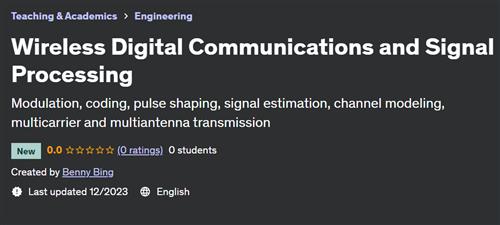Wireless Digital Communications and Signal Processing

Free Download Wireless Digital Communications and Signal Processing
Published 12/2023
Created by Benny Bing
MP4 | Video: h264, 1280x720 | Audio: AAC, 44.1 KHz, 2 Ch
Genre: eLearning | Language: English | Duration: 16 Lectures ( 4h 38m ) | Size: 1.63 GB
Modulation, coding, pulse shaping, signal estimation, channel modeling
What you'll learn:
Understand the principles of wireless signal transmission
Apply channel models, pulse shaping, multi-level modulation, and digital coding in wireless systems
Learn equalization techniques, matched filtering, and spectral estimation
Design and optimize digital beamforming and multiple antenna systems
Review multicarrier systems and estimate the impact of frequency offset
Requirements:
A background in wireless communications and digital signal processing
Description:
Wireless networks have expanded beyond person-to-person communications, connecting not only users but also machines, devices, and objects. This course will cover the fundamental principles of wireless digital communications and describe the role of digital signal processing in driving wireless communications technologies. Participants will learn how to analyze the performance of digital modulation techniques such as quadrature amplitude modulation (QAM) and apply them in modern wireless systems. High-order modulation (such as 256-QAM, 1024-QAM) achieves greater spectral efficiency, thus leading to higher data rates. They form the basis of current and emerging wireless standards (such as 5G and Wi-Fi). By changing the modulation and coding, the available data rate and robustness of the wireless signal can be adapted to deployment conditions. The Nyquist Theorem allows bandlimited continuous-time signals to be represented by their discrete-time samples. Consequently, a wireless communications system, including channel impairments like multipath fading and noise, can be analyzed in terms of their discrete-time equivalents. Linear time-invariant systems, which are characterized by convolution with an impulse response, can be used to model wireless channels. Deconvolution can be used to equalize the effects of the channel. Upsampling, downsampling, and multirate signal processing allow efficient implementation of pulse shaping at the transmitter and matched filtering at the receiver. This course will present many DSP tools that are relevant to wireless system design, analysis, and optimization. Other practical topics are multiple antenna signal processing (transmit beamforming, spatial multiplexing, and space-time coding), noise-shaping modulation, advanced data converters, fractional-N phase-locked loops, sampling receivers, N-path filters, and pre-distortion linearization.
Who this course is for:
Wireless signal processing engineers
Homepage
https://www.udemy.com/course/wireless-digital-communications-and-signal-processing/Rapidgator
fouqj.Wireless.Digital.Communications.and.Signal.Processing.part2.rar.html
fouqj.Wireless.Digital.Communications.and.Signal.Processing.part1.rar.html
Uploadgig
fouqj.Wireless.Digital.Communications.and.Signal.Processing.part2.rar
fouqj.Wireless.Digital.Communications.and.Signal.Processing.part1.rar
NitroFlare
fouqj.Wireless.Digital.Communications.and.Signal.Processing.part2.rar
fouqj.Wireless.Digital.Communications.and.Signal.Processing.part1.rar
Fikper
fouqj.Wireless.Digital.Communications.and.Signal.Processing.part1.rar.html
fouqj.Wireless.Digital.Communications.and.Signal.Processing.part2.rar.html
Wireless Digital Communications and Signal Processing Torrent Download , Wireless Digital Communications and Signal Processing Watch Free Online , Wireless Digital Communications and Signal Processing Download Online
In today's era of digital learning, access to high-quality educational resources has become more accessible than ever, with a plethora of platforms offering free download video courses in various disciplines. One of the most sought-after categories among learners is the skillshar free video editing course, which provides aspiring creators with the tools and techniques needed to master the art of video production. These courses cover everything from basic editing principles to advanced techniques, empowering individuals to unleash their creativity and produce professional-quality content.


Comments (0)
Users of Guests are not allowed to comment this publication.